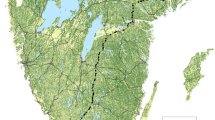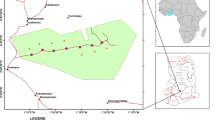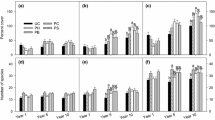Abstract
In afforestation, studies of forest edges seldom span the effects of planting design and the self-designing capacities of spontaneous vegetation. This study revisited experimental forest edge sections 16 years after their establishment to assess the impact of five design elements on (1) horizontal and vertical edge structure, (2) growth of planted species and species groups, and (3) spontaneous establishment of woody vegetation. The design elements were: exposure to direct solar radiation; edge typology (shrub mixture, mixture of trees and shrubs, no edge planting); width of edge planting (5 or 10 m); species mixture principle (intimate mixtures or single species grouping); and planting row position from outermost to interior planting row (max. 6 rows). The results demonstrate that edge plantings support significantly more spontaneous woody vegetation than stand boundaries without such edge plantings. This result was consistent across the different design elements. Position across the planting rows from the outermost to innermost row was the most influential design element for the development of planted seedlings. Planted tree and shrub species of similar shade tolerance had contradicting development, where light-demanding pioneer tree species had obtained dominant positions while shade-tolerant shrub species had outgrown more light-demanding species. These results demonstrate that important successional processes can be activated by establishing the initial components and structures of forest edges. When designing such edges, species should preferably be allocated to different row cohorts reflecting their growth form and shade tolerance.




Similar content being viewed by others
References
Andersen SS, Hübertz H, Nielsen TS (1994) Trœer og buske i skovbryn—artsammensœtning og struktur (Trees and shrubs in forest edges—species and structure). Dan Skovbr Tidskr 79:18–36
Bauhus J, Van der Meer P, Kanninen M (2010) Ecosystem goods and services from plantation forests. Earthscan, London
Bell S, Blom D, Rautamäki M, Castel-Branco C, Simson A, Olsen IA (2005) Design of urban forests. In: Konijnendijk CC, Nilsson K, Randrup TB, Schipperijn J (eds) Urban forests and trees. Springer, Berlin, pp 149–186
Bergen SD, Bolton SM, Fridley JL (2001) Design principles for ecological engineering. Ecol Eng 18:201–210
Blakesley D (2006) Woodland creation for wildlife: a guide to creating new woodland for wildlife in Kent and East Sussex. East Malling Research, East Malling
Brothers TS, Spingarn A (1992) Forest fragmentation and alien plant invasion of central indiana old-growth forests. Conserv Biol 6:91–100
Bubi JW (2009) Created grassland diversity after 12 years of mowing in southern Sweden. MSc Thesis in Conservation Biology, University of Nairobi
Buckley GP, Howell R, Watt TA, Ferris-Kaan R, Anderson MA (1997) Vegetation succession following ride edge management in lowland plantations and woods. 1. The influence of site factors and management practices. Biol Conserv 82:289–304
Carter CJ (1989) Ride orientation and invertebrate activity. In: Ferris-Kaan R (ed) Edge management in woodlands. Forestry Commission, Farnham, pp 17–21
Ciccarese L, Mattsson A, Pettenella D (2012) Ecosystem services from forest restoration: thinking ahead. New For 43:543–560
Connell JH, Slatyer RO (1977) Mechanisms of succession in natural communities and their role in community stability and organization. Am Nat 111:1119–1144
Coomes DA, Grubb PJ (2000) Impacts of root competition in forests and woodlands: a theoretical framework and review of experiments. Ecol Monogr 70:171–207
Dierschke H (1974) Saumgesellschaften im vegetations-und standortgefälle and waldrändern. Verlag Erich Goltze KG, Göttingen
Dunnet N (2004) Shrub mosaics and woodland edge. ‘Natural’ models for shrub planting. In: Hitchmough J, Fileldhouse K (eds) Plant user handbook. Blackwell Publishing, Oxford, pp 167–174
Fitter A, Peat H (1994) The ecological flora database. J Ecol 82:415–425
Fraser S, Buckley GP (2000) The farm woodland premium scheme in England, with particular reference to participants in Kent and East Sussex. In: Yoshimoto A (ed) Optimal management in farm woodlands. Miyazaki University, Miyazaki
Fry G, Sarlöv-Herlin I (1997) The ecological and amenity functions of woodland edges in the agricultural landscape, a basis for design and management. Landsc Urban Plan 37:45–55
Fuller RJ (1989) Effects of woodland edges on songbirds. In: Ferris-Kaan R (ed) Edge management in woodlands. Forestry Commission, Farnham, pp 31–34
Geiger R (1965) The climate near the ground. Harvard University Press, Cambridge
Gustavsson R (1986) Struktur i lövskogslandskap (Structure in the broadleaved landscape). Dissertation, Swedish University of Agricultural Sciences
Gustavsson R (2002) Afforestation in and near urban areas. In: Randrup TB (ed) Urban Forest and Trees; Proceedings No 1. Cost Action E12, Directorate-General for Research, EUR 19861, Brussels, pp 286–314
Gustavsson R (2004) Exploring woodland design: designing with complexity and dynamics—woodland types, their dynamic architecture and establishment. In: Dunnet N, Hitchmough J (eds) The dynamic landscape. Taylor & Francis, London, pp 184–214
Gustavsson R, Ingelög T (1994) Det nya landskapet-kunskaper och idéer om naturvård, skogsodling och planering i kulturbygd (The New Landscape-facts and concepts about nature conservation silviculture and planning in cultural landscapes). Skogsstyrelsen, Jönköping
Guzmán-Guzmán J, Williams-Linera G (2006) Edge effect on acorn removal and oak seedling survival in mexican lower montane forest fragments. New For 31:487–495
Hamberg L, Lehvävirta S, Kotze DJ (2009) Forest edge structure as a shaping factor of understorey vegetation in urban forests in Finland. For Ecol Manage 257:712–722
Harper KA, Macdonald SE, Burton PJ, Chen J, Brosofske KD, Saunders SC, Euskirchen ES, Roberts D, Jaiteh MS, Esseen PA (2005) Edge influence on forest structure and composition in fragmented landscapes. Conserv Biol 19:768–782
Hladnik D (2005) Spatial structure of disturbed landscapes in Slovenia. Ecol Eng 24:17–27
Hodge SJ (1995) Creating and managing woodlands around towns. Forestry Commission, London
Kollmann J (1995) Regeneration window for fleshy-fruited plants during scrub development on abandoned grassland. Ecoscience 2:213–222
Larsen JB, Nielsen AB (2012) Urban forest landscape restoration—applying forest development types in design and planning. In: Stanturf J, Lamb D, Madsen P (eds) Forest landscape restoration: integrating natural and social science. Springer, Dordrecht, pp 177–199
Lawesson JE, Oksanen J (2002) Niche characteristics of Danish woody species as derived from coenoclines. J Veg Sci 13:279–290
Lindenmayer DB, Fischer J (2007) Edge effects. In: Lindenmayer DB, Hobbs RJ (eds) Managing and designing landscapes for conservation: moving from perspectives to principles. Blackwell Publishing, Oxford, pp 165–178
Matlack GR (1993) Microenvironment variation within and among forest edge sites in the eastern United States. Biol Conserv 66:185–194
Matlack GR (1994) Vegetation dynamics of the forest edge—trends in space and successional time. J Ecol 82:113–123
Matlack GR, Litvaitis J (1999) Forest edges. In: Malcom LHJ (ed) Maintaining biodiversity in forest ecosystems. Cambridge University Press, Cambridge, pp 210–233
Nielsen AB (2011) Landscape laboratories 2008–10. Guided and supervised activities and publications. Rapportserie: Landskap Trädgård Jordbruk, Swedish University of Agricultural Sciences, Alnarp
Nielsen AB, Jensen RB (2007) Some visual aspects of planting design and silviculture across contemporary forest management paradigms–perspectives for urban afforestation. Urban For Urban Green 6:143–158
Nielsen AB, Konijnendijk CC, Wiström B, Jensen RB (2013) Municipal woodland in Denmark: resources, governance and management. Scand J For Res 28:49–63
Peat H, Fitter A, Ford H (2012) The ecological flora database. British Ecological Society, Natural Environment Research Council. http://www.ecoflora.co.uk. Accessed Mar 1 2012
Pihlgren A (2009) Föryngring av ek och rönn i betesmarker med hjälp av buskar och konstgjorda betesskydd (Seedling establishment of Quercus robur and Sorbus aucuparia in shrubs and artificial grazing refuges). Svensk Botanisk Tidskr 103:183–186
Ranney JW, Bruner MC, Levenson JB (1981) The importance of edge in the structure and and dynamics of forest islands. In: Burgess RL, Sharpe DM (eds) Forest islands dynamics in man-dominated landscapes. Springer, New York, pp 67–96
Richnau G, Wiström B, Nielsen AB, Löf M (2012) Creation of multi-layered canopy structures in young oak-dominated urban woodlands–The ‘ecological approach’ revisited. Urban For Urban Green 11:147–158
Ries L, Fletcher RJ, Battin J, Sisk TD (2004) Ecological responses to habitat edges: mechanisms, models, and variability explained. Annu Rev Ecol Evol Syst 35:491–522
Rizell M, Gustavsson R (1998) Att anlägga skogsbryn. Modeller och referenser för anläggning och rekonstruktion (Construction of forest edges. Models and references for construction and reconstruction). Movium, Alnarp
Rodwell JS (ed) (1991) British plant communities volume 1. Woodlands and scrub. Cambridge University Press, Cambridge
Sack L (2004) Responses of temperate woody seedlings to shade and drought: do trade-offs limit potential niche differentiation? Oikos 107:110–127
Sarlöv-Herlin I (1999) Edge habitats in agricultural landscapes: woody species, landscape ecology and implications for planning. Dissertation, Swedish University of Agricultural Sciences
Sarlöv-Herlin I, Fry G (2000) Dispersal of woody plants in forest edges and hedgerows in a Southern Swedish agricultural area: the role of site and landscape structure. Landsc Ecol 15:229–242
Scherer-Lorenzen M, Potvin C, Koricheva J, Schmid B, Hector A, Bornik Z, Reynolds G, Schulze ED (2005) The design of experimental tree plantations for functional biodiversity research. In: Scherer-Lorenzen M, Körner C, Schulze ED (eds) Forest diversity and function. Temperate and boreal systems, vol 176. Springer, New York, pp 347–376
Shannon CE, Weaver W (1962) The mathematical theory of communication. University of Illinois Press, Urbana
Sisk TD (2007) Incorporating edge effects into landscape design and management. In: Lindenmayer DB, Hobbs RJ (eds) Managing and designing landscapes for conservation: moving from perspectives to principles. Blackwell publishing, Oxford, pp 151–164
Sjörs H (1967) Nordisk växtgeografi. (Nordic plant geography). Bonnier, Stockholm
Smith GF, Iremonger S, Kelly KL, O′Donoghue S, Mitchell FJG (2007) Enhancing vegetation diversity in glades, rides and roads in plantation forests. Biol Conserv 136:283–294
Stanturf JA, Schoenholtz SH, Schweitzer CJ, Shepard JP (2001) Achieving restoration success: myths in bottomland hardwood forests. Restor Ecol 9:189–200
Turner MG, Gardner RH, O′Neill RV (2001) Landscape ecology in theory and practice. Springer, New York
van Andel J, Grootjans AP (2006) Concepts in restoration ecology. In: Aronsson J, van Andel J (eds) Restoration ecology. Blackwell Science, Oxford, pp 16–28
Wales BA (1972) Vegetation analysis of north and south edges in a mature oak-hickory forest. Ecol Monogr 42:451–471
Warren MS, Thomas JA (1992) Butterfly responses to coppicing. In: Buckley GP (ed) Ecology and management of coppice woodlands. Chapman and Hall, London, pp 249–270
Whittaker RH (1967) Gradient analysis of vegetation. Biol Rev 42:207–264
Woodburn MIA (1989) Gamebirds and woodland edges. In: Ferris-Kaan R (ed) Edge management in woodlands. Forestry Commission, Farnham, pp 35–41
Acknowledgments
This project was funded by the Swedish Transport Administration and the Swedish Research Council FORMAS. We acknowledge the editors and anonymous referees for their valuable comments and suggestions.
Author information
Authors and Affiliations
Corresponding author
Appendix
Appendix
Rights and permissions
About this article
Cite this article
Wiström, B., Nielsen, A.B. Effects of planting design on planted seedlings and spontaneous vegetation 16 years after establishment of forest edges. New Forests 45, 97–117 (2014). https://doi.org/10.1007/s11056-013-9394-4
Received:
Accepted:
Published:
Issue Date:
DOI: https://doi.org/10.1007/s11056-013-9394-4




